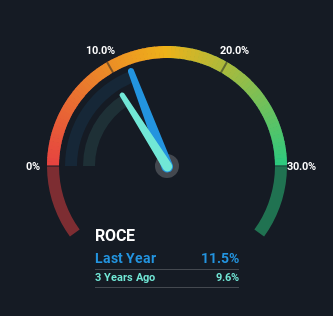- Hong Kong
- /
- Oil and Gas
- /
- SEHK:9689
Returns On Capital Signal Tricky Times Ahead For JTF International Holdings (HKG:9689)

What are the early trends we should look for to identify a stock that could multiply in value over the long term? Firstly, we'll want to see a proven return on capital employed (ROCE) that is increasing, and secondly, an expanding base of capital employed. This shows us that it's a compounding machine, able to continually reinvest its earnings back into the business and generate higher returns. Although, when we looked at JTF International Holdings (HKG:9689), it didn't seem to tick all of these boxes.
What Is Return On Capital Employed (ROCE)?
For those who don't know, ROCE is a measure of a company's yearly pre-tax profit (its return), relative to the capital employed in the business. Analysts use this formula to calculate it for JTF International Holdings:
Return on Capital Employed = Earnings Before Interest and Tax (EBIT) ÷ (Total Assets - Current Liabilities)
0.12 = CN¥50m ÷ (CN¥477m - CN¥43m) (Based on the trailing twelve months to June 2023).
Thus, JTF International Holdings has an ROCE of 12%. In absolute terms, that's a satisfactory return, but compared to the Oil and Gas industry average of 6.7% it's much better.
See our latest analysis for JTF International Holdings

Historical performance is a great place to start when researching a stock so above you can see the gauge for JTF International Holdings' ROCE against it's prior returns. If you're interested in investigating JTF International Holdings' past further, check out this free graph of past earnings, revenue and cash flow.
What Does the ROCE Trend For JTF International Holdings Tell Us?
On the surface, the trend of ROCE at JTF International Holdings doesn't inspire confidence. Around five years ago the returns on capital were 27%, but since then they've fallen to 12%. Although, given both revenue and the amount of assets employed in the business have increased, it could suggest the company is investing in growth, and the extra capital has led to a short-term reduction in ROCE. And if the increased capital generates additional returns, the business, and thus shareholders, will benefit in the long run.
On a related note, JTF International Holdings has decreased its current liabilities to 9.0% of total assets. That could partly explain why the ROCE has dropped. What's more, this can reduce some aspects of risk to the business because now the company's suppliers or short-term creditors are funding less of its operations. Some would claim this reduces the business' efficiency at generating ROCE since it is now funding more of the operations with its own money.
What We Can Learn From JTF International Holdings' ROCE
Even though returns on capital have fallen in the short term, we find it promising that revenue and capital employed have both increased for JTF International Holdings. Furthermore the stock has climbed 97% over the last five years, it would appear that investors are upbeat about the future. So while investors seem to be recognizing these promising trends, we would look further into this stock to make sure the other metrics justify the positive view.
JTF International Holdings does come with some risks though, we found 3 warning signs in our investment analysis, and 1 of those is a bit unpleasant...
For those who like to invest in solid companies, check out this free list of companies with solid balance sheets and high returns on equity.
If you're looking to trade JTF International Holdings, open an account with the lowest-cost platform trusted by professionals, Interactive Brokers.
With clients in over 200 countries and territories, and access to 160 markets, IBKR lets you trade stocks, options, futures, forex, bonds and funds from a single integrated account.
Enjoy no hidden fees, no account minimums, and FX conversion rates as low as 0.03%, far better than what most brokers offer.
Sponsored ContentNew: Manage All Your Stock Portfolios in One Place
We've created the ultimate portfolio companion for stock investors, and it's free.
• Connect an unlimited number of Portfolios and see your total in one currency
• Be alerted to new Warning Signs or Risks via email or mobile
• Track the Fair Value of your stocks
Have feedback on this article? Concerned about the content? Get in touch with us directly. Alternatively, email editorial-team (at) simplywallst.com.
This article by Simply Wall St is general in nature. We provide commentary based on historical data and analyst forecasts only using an unbiased methodology and our articles are not intended to be financial advice. It does not constitute a recommendation to buy or sell any stock, and does not take account of your objectives, or your financial situation. We aim to bring you long-term focused analysis driven by fundamental data. Note that our analysis may not factor in the latest price-sensitive company announcements or qualitative material. Simply Wall St has no position in any stocks mentioned.
About SEHK:9689
JTF International Holdings
An investment holding company, engages in the blending and selling of fuel oil in the People’s Republic of China.
Flawless balance sheet low.
Similar Companies
Market Insights
Community Narratives



